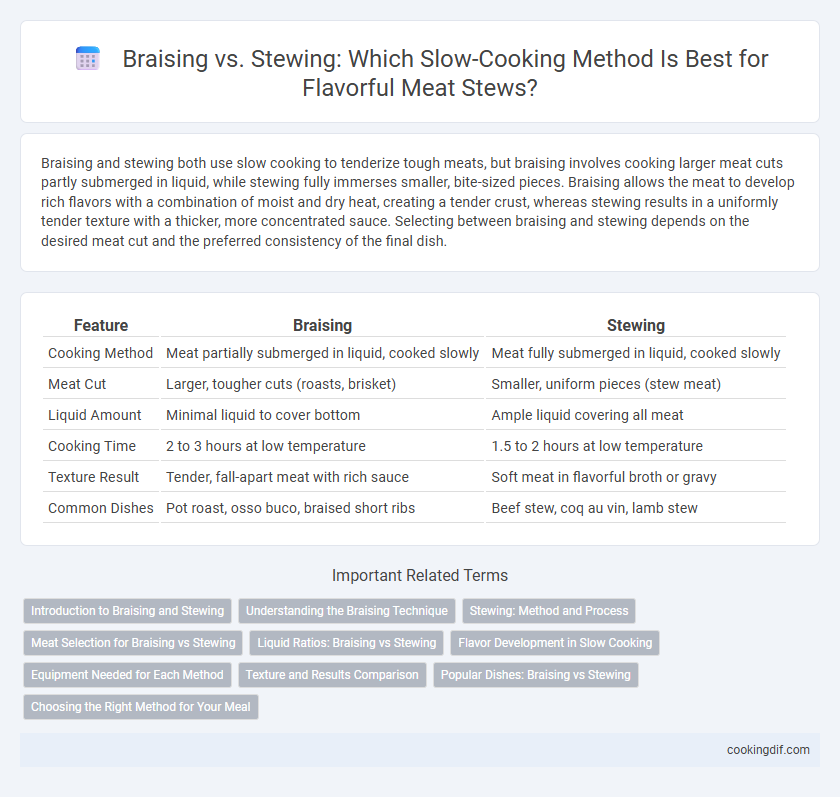Braising and stewing both use slow cooking to tenderize tough meats, but braising involves cooking larger meat cuts partly submerged in liquid, while stewing fully immerses smaller, bite-sized pieces. Braising allows the meat to develop rich flavors with a combination of moist and dry heat, creating a tender crust, whereas stewing results in a uniformly tender texture with a thicker, more concentrated sauce. Selecting between braising and stewing depends on the desired meat cut and the preferred consistency of the final dish.
Table of Comparison
| Feature | Braising | Stewing |
|---|---|---|
| Cooking Method | Meat partially submerged in liquid, cooked slowly | Meat fully submerged in liquid, cooked slowly |
| Meat Cut | Larger, tougher cuts (roasts, brisket) | Smaller, uniform pieces (stew meat) |
| Liquid Amount | Minimal liquid to cover bottom | Ample liquid covering all meat |
| Cooking Time | 2 to 3 hours at low temperature | 1.5 to 2 hours at low temperature |
| Texture Result | Tender, fall-apart meat with rich sauce | Soft meat in flavorful broth or gravy |
| Common Dishes | Pot roast, osso buco, braised short ribs | Beef stew, coq au vin, lamb stew |
Introduction to Braising and Stewing
Braising and stewing are popular slow-cooking techniques used to tenderize tough cuts of meat through prolonged exposure to low heat and moisture. Braising involves cooking larger cuts partially submerged in liquid, often starting with a sear for enhanced flavor, while stewing requires smaller, uniformly cut pieces fully immersed in liquid. Both methods break down collagen into gelatin, resulting in rich, flavorful dishes ideal for hearty meals.
Understanding the Braising Technique
Braising involves searing meat at high heat before cooking it slowly in a small amount of liquid, typically covering only half of the meat, which allows for a tender texture and rich flavor development. This technique uses less liquid than stewing, preserving the meat's natural juices while infusing subtle aromas from herbs, spices, and aromatics. The controlled moisture and gentle heat in braising break down connective tissue efficiently, producing succulent cuts ideal for tougher meats like beef brisket or pork shoulder.
Stewing: Method and Process
Stewing involves fully submerging smaller pieces of meat in liquid, allowing gentle simmering over low heat for an extended period. This method breaks down connective tissues, resulting in tender, flavorful meat infused with the cooking broth. Ideal for tougher cuts like beef chuck or lamb shanks, stewing emphasizes slow, moist heat that melds ingredients into a rich, cohesive dish.
Meat Selection for Braising vs Stewing
Braising typically suits larger, tougher cuts of meat such as brisket, shank, or short ribs that benefit from slow cooking in a small amount of liquid to break down connective tissue. Stewing works best with smaller, uniformly cut pieces from tougher muscles like chuck or round, allowing even cooking and tenderizing as the meat simmers fully submerged. Selecting the appropriate cut ensures optimal texture and flavor extraction during the slow-cooking process.
Liquid Ratios: Braising vs Stewing
Braising typically uses a smaller amount of liquid, just enough to partially submerge the meat--usually about one-third to halfway up the sides--allowing the meat to brown and slowly cook in its own juices combined with the liquid. Stewing requires enough liquid to fully cover the meat, often a 1:1 or greater meat-to-liquid ratio, resulting in tender, uniformly cooked pieces immersed in a rich sauce. The differing liquid ratios impact texture and flavor concentration, with braising producing a thicker sauce and stewing yielding a more brothy consistency.
Flavor Development in Slow Cooking
Braising and stewing both enhance flavor development through slow cooking, but braising uses less liquid and typically cooks larger meat cuts, allowing a concentrated, caramelized depth of flavor from browning. Stewing fully submerges smaller meat pieces, fostering rich, uniform tenderness as the meat absorbs braising juices and spices over extended heat exposure. Both methods rely on collagen breakdown and Maillard reactions to produce complex, savory profiles essential to hearty slow-cooked dishes.
Equipment Needed for Each Method
Braising requires a heavy, oven-safe pot such as a Dutch oven that can maintain a consistent low temperature and accommodate both stovetop and oven use. Stewing typically uses a deep pot or slow cooker with a tight-fitting lid to ensure even heat distribution and moisture retention during the longer cooking time. Both methods benefit from equipment that supports slow, gentle heat to tenderize tough cuts of meat effectively.
Texture and Results Comparison
Braising involves cooking larger cuts of meat partially submerged in liquid, resulting in tender, sliceable textures with a rich, concentrated flavor. Stewing uses smaller, uniform pieces fully submerged in liquid, producing a softer, melt-in-the-mouth consistency as the meat breaks down evenly. Both methods tenderize tough cuts, but braising offers firmer bites while stewing yields a more cohesive, stew-like texture.
Popular Dishes: Braising vs Stewing
Braising techniques shine in popular dishes like beef brisket and coq au vin, where large cuts are seared and slowly cooked in minimal liquid to develop deep, rich flavors. Stewing is favored for recipes such as beef stew or goulash, involving smaller meat pieces fully submerged in flavorful broth for even tenderization. Both methods transform tough cuts into succulent meals, highlighting regional variations within global slow-cooked culinary traditions.
Choosing the Right Method for Your Meal
Braising involves cooking larger cuts of meat partially submerged in liquid at low temperatures, which helps maintain tenderness and develop deep flavor profiles, ideal for tougher cuts like brisket or short ribs. Stewing requires smaller, uniform pieces of meat fully submerged in liquid, allowing for even cooking and a rich, hearty texture perfect for dishes like beef stew or chicken cacciatore. Selecting between braising and stewing depends on the cut size and desired texture, with braising better for preserving structure and stewing for creating tender, cohesive meals.
Braising vs stewing for slow-cooked meats Infographic

 cookingdif.com
cookingdif.com